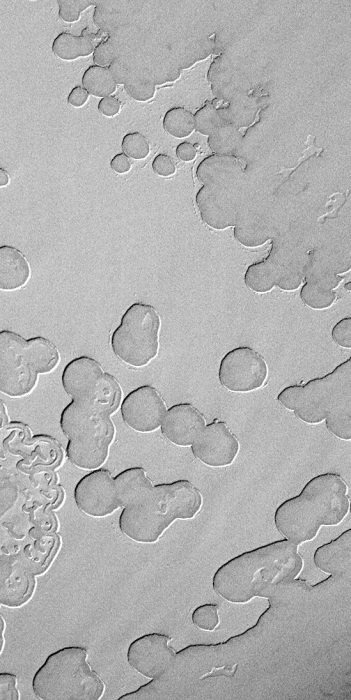A brand new photo of Mars has created a little mystery. Recently, NASA's Mars Reconnaissance Orbiter (MRO) took a picture of the Martian south pole, which showed the surface covered by carbon dioxide ice. Areas where the ice had melted off left behind numerous holes. This led the researchers to call it "Swiss cheese terrain."
In fact, the ice hasn't melted at all. Instead, this Swiss cheese CO2 ice has gone through sublimation, which is a...
Oops, sorry. All this talk of cheese made us hungry! Anyway, where were we? Yes, sublimation!
This is a process where a solid turns directly into a gas. That's why we're not seeing the carbon dioxide ice floating in some carbon dioxide puddles. This ice is skipping the liquid state completely. Neat, right?

Another photo showing Martian Swiss cheese terrain. (NASA/JPL/MSSS)
What made the hole?
But hey! The title of this post promised a mystery! We want a mystery!
Sit tight, here it comes. Because while scientists feel they have this "hole" Swiss cheese thing figured out, the giant opening in the top right corner of the photo is much more baffling. (Though it might look smallish in the picture, this feature is actually hundreds of metres across in the real life, or the length of a few football fields put together.)

This is a Martian crater called Endeavour, which was created by a meteorite hitting the surface. Do you think it looks anything like the Swiss cheese pit in our first photo? Or was that created by something different? (NASA/JPL-Caltech/Malin Space Science Systems)
It could be a crater made by something colliding with the planet's surface. It could be the result of ancient floods on the surface of the planet. Or it might have been made by the volcanic activity under the surface that led to a collapse.
Either way, it is a great example of how scientists are just scratching the surface when it comes to understanding Martian geology. If you look closely, you can see more carbon dioxide ice deep inside the pit. Will we live to see the day when humans land on Mars to explore this very spot?
In the mean time... who's hungry?
 What exactly is this hole in the surface of the Martian south pole? Scientists aren't sure, but they have guesses... (NASA/JPL-Caltech/Univ. of Arizona)
What exactly is this hole in the surface of the Martian south pole? Scientists aren't sure, but they have guesses... (NASA/JPL-Caltech/Univ. of Arizona)









